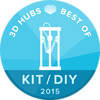Hello All , i was started with 3d printing last year oktober , with delta Kossel mini.
i build it bigger so the heatbed (200x200mm) fitted on , i wanted to print abs ,pla , and all others .
Build volume 230mm in round and 260mm hight. Extruder is MK7-based-i tuned it up for flex and so on .
Hotend is the bowden with also tuned up cooling. also easy changing hotend .Look the picture.
I have to close around the printer with plynwood .the heat is gone to fast. Stil working on it .
Make absorbers under it ,and the printer is stady, i made also stabilators for the legs ,now he is stiff and goes on.
Finaly, the printer was fast builded and not expensive (€400).
The calibration was an other story :
Nothing on the internet was really helpfull.only an few people pionted in the right way.
like Rich Horn :Richrep. thanks to him , i made my own guide for the printer .calibration is not that hard .anymore.
Like driving an car ,you must learn to handle the machine ,every machine .and on you go.
The printer is fast .an friend has the mendel 90 ,well tuned and is 2x slower then mine .
And it is accurate.Mine level is high, 0,10mm with nozzle 0,30mm 1,75mm filament.
Our baby sleeps next door .and never woke up ,and the doors where open , silent it is .the vents makes most noise.
The only cons of the delta is ,For me , i can’t print with 2 hotends ,so with multycolourprints ,i programmed the gcode .
to an parking level and change filament then resume print , never had an problem with that ,it take only more time to
programm but this is also learned easy.
Next printer is the big mendel i think with makerbeam alu.and closed compleet .Like Richrep made one .
I still want to print in 2 or more colours in one run .
If somebody want : the guide i made for me is in the marlin software build in .
So i can send it to you as zip .Just ask . You can use it for other printers as well , it is an guide for handle and doing.
3D-printng is working with high precision machines , well tuned ,makes it every thing you want .
I have printed now with mine 2 delta’s kosselmidi 8 spools = 8KG. and only 600gr carvisch rest.in just 12 months.
is that good for an Newbee ?
thanks for reading all and keep up printing .!

 so the only consumable is filament - same as all the other printers, except you don’t have to use a raft or brim, or skirt …
so the only consumable is filament - same as all the other printers, except you don’t have to use a raft or brim, or skirt … Thanks for sharing this with us, James! I’m sure that many UMO owners agree withy you.
Thanks for sharing this with us, James! I’m sure that many UMO owners agree withy you.